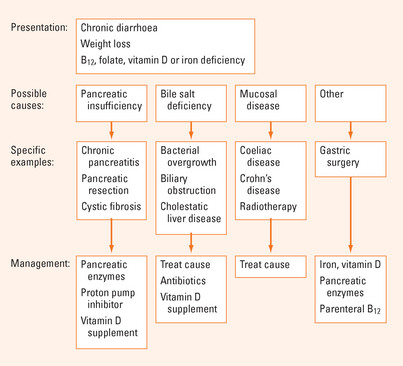Chapter 11 MALABSORPTIVE DISORDERS AND COELIAC DISEASE
INTRODUCTION
The body obtains nutrients from food by the absorption of food components that have been broken down by digestion. Malabsorption is the failure of the processes of digestion and absorption, and may present with weight loss, bloating, diarrhoea and a myriad of specific vitamin and nutrient deficiencies. Identification of the underlying cause and replacement of vitamin and nutrient deficiencies are the cornerstones of management (see Figure 11.1). An aetiologic classification of malabsorption is listed in Table 11.1 with the types commonly seen in clinical practice summarised in Table 11.2.
TABLE 11.1 Classification of malabsorption
| Pancreatic insufficiency | Mucosal disease |
| Bile salt deficiency | |
| Other | |
BILE SALT DEFICIENCY
Bacterial overgrowth
In health, the bacteria that are cultured from the small intestinal lumen are transiently present in counts of less than 104 per mL of jejunal content. Stasis of luminal contents due to impaired motility or structural abnormalities can result in bacterial overgrowth. Excess bacteria can produce malabsorption by deconjugating bile salts, rendering them inadequate for micelle formation and fat digestion. Bacterial-induced B12 deficiency may also occur.
Stay updated, free articles. Join our Telegram channel

Full access? Get Clinical Tree










